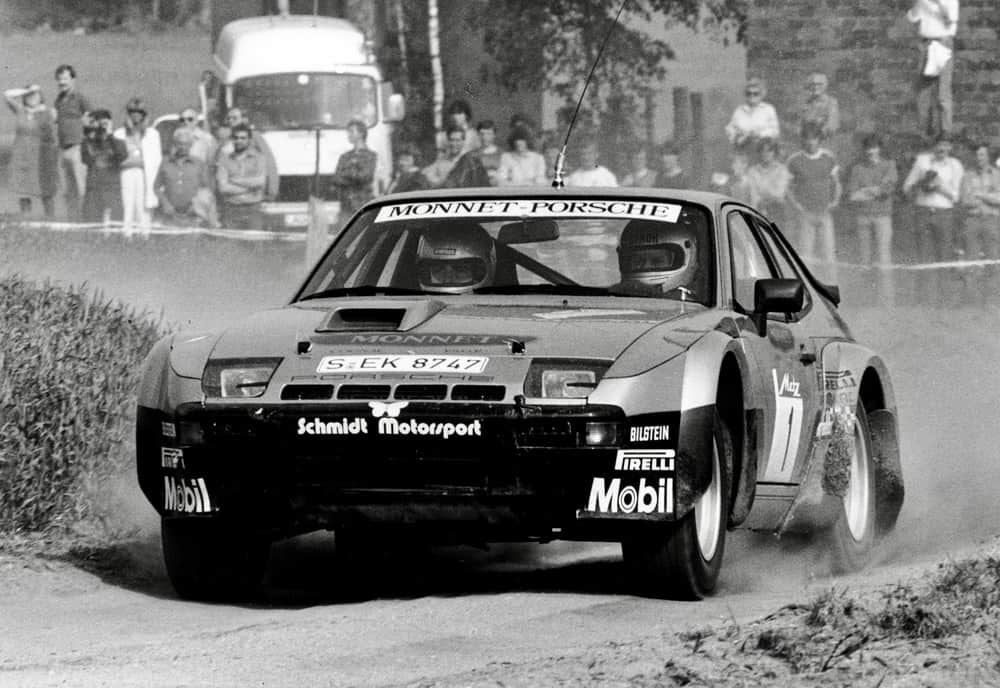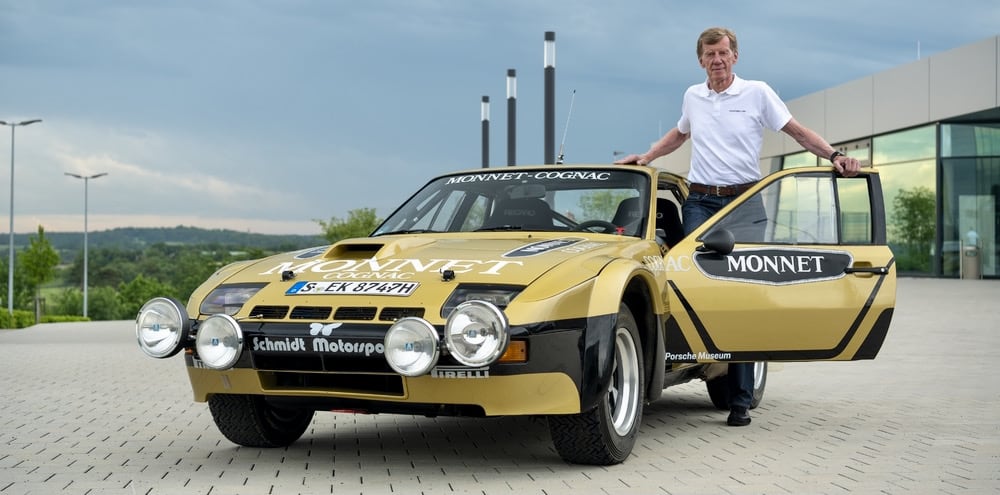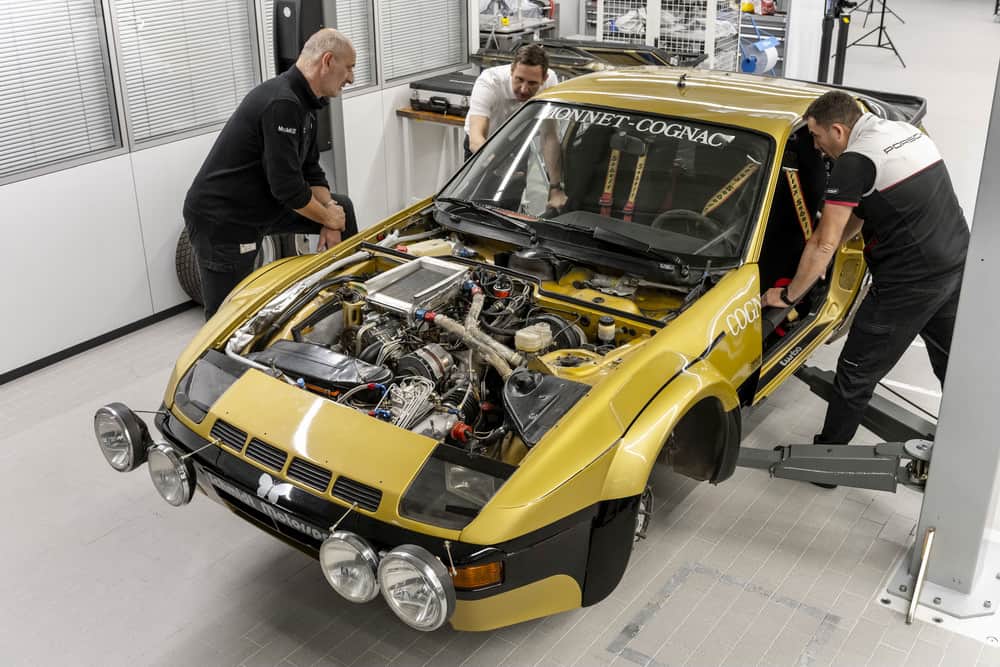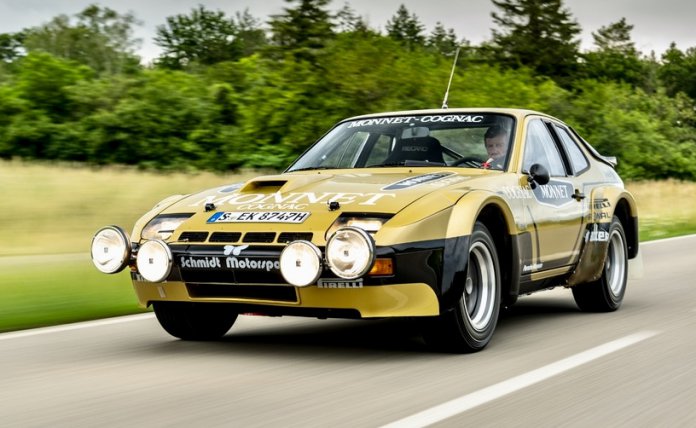Walter Röhrl won the World Rally Championship in 1980 and in 1982 with Fiat and Opel, respectively, and later would become known for his performances with Audi. But in 1981, Röhrl raced with Porsche, driving a 924 Carrera GTS in the German rally series, a 911 SC in World events, and joining Jurgen Barth in a 944 LM to finish seventh overall in the 24 Hours of Le Mans.
Forty years later, Porsche surprised Röhrl by reuniting him with the 924 Carrera GTS, now restored in its rally-ready gold-and-black colors.
That 1981 German Rally Championship season didn’t start well for the Porsche team. It took a couple of events to get the car, nicknamed “Monnet,” sorted, but Röhrl and co-driver Christian Geistdörfer responded with victories in the Hessen, Serengeti Safari, Anterior Palatinate and Baltic events to win the season championship.
Season over, “test car 924 GTS” was put into storage in the Porsche Museum.
Unknown to Röhrl, the car was later sent to Porsche’s historic motor racing department in Weissach to be recommissioned while preserving “the traces of time.”

“The biggest problem in recommissioning the car was not the technology, but keeping it secret,” according to Kuno Werner, head of the museum workshop.”
The goal was to unveil the car at Röhrl’s front door on his recent and 74th birthday. “But Walter Röhrl knows so many people here that it was difficult to keep the project secret,” Werner added.
But the secret was kept.
“It was a huge surprise for me,” the famed driver is quoted in Porsche’s news release about the project. “I stepped out of the car 40 years ago and haven’t sat in it again since. So I was astonished when Roland showed up all of a sudden in this car.

“This car opened the door to Porsche for me,” said Rohrl, who has had a long run as a Porsche consultant and test driver. “That is why I feel a particularly close bond to it. For me, it’s a journey back in time. I immediately feel 40 years younger.”
The car was driven from the Porsche workshop to Rohrl’s home by Roiland Kussmaul, himself a rally driver, Porsche engineer, and the test driver in the 924 GTS development. Kussmaul was part of the team that in just two months turned the fifth of nine prototypes into a championship-winning rally racer.
The car was powered by a 2.0-liter 4-cylinder turbocharged engine that also was a test model and bears no serial number. The engine survived the season without damage and has driven the car 10,371 kilometers in and away from competition.
“The focus of recommissioning was ensuring complete originality down to the very last detail and also preserving the car’s patina,” Porsche said in its news release. “Even the slightly sun-faded red seat belt harnesses under the large glass dome are still the originals. A large R is embroidered on the harness on the driver side, and the combination CG on the passenger side: Röhrl and Christian Geistdörfer.”
The car still bears the handwriting notes of those who built it, Porsche added.
“The special features of the 924 in rally trim included the rear-axle links laminated in glass-fiber plastic as protection against stone damage, thick metal plates on the underbody as protection for the oil pan and gearbox, as well as the fuel distributor from the V8 engine in its big Type 928 relation, which ensured the fuel supply to the engine at high engine speeds,” according to Porsche. “The dry sump for the oil supply was located at the rear and was filled through an opening next to the luggage compartment lock.

“The basis of the rally car, the 924 Carrera GTS, was the most expensive car in the model range in 1981 with a price of 110,000 marks, a price tag that also made it the most expensive production Porsche of all time up to that point,” the company noted.
“With the Carrera models from the 924 series, Porsche proved that the transaxle concept could also be successful in motorsport. The 924 Turbo (Type 931) provided the basis for further development. The enhanced 924 Carrera GT (Type 937) with 210 (horsepower) was presented in June 1980 and was homologated for Group 4. Its more powerful development version was the 924 Carrera GTS (Type 939). The standard GTS delivered 240 (horsepower) and the Clubsport variant 275 (horsepower), while the GTR designed exclusively for race track use achieved an output of 375.
“The production runs remained small: between February and April, 50 left-hand-drive 924 Carrera GTS were built, all painted in the color Guards Red. Including all prototypes, a total of 59 cars were produced.”
During the restoration, nearly all components were overhauled, rebuilt and reinstalled, Porsche says. The Porsche Museum workshop had a race clutch in stock, and Pirelli provided a vintage set of 255/55 R15 tires.

“Turbocharging was new 40 years ago,” Porsche points out. “And also unaccustomed, as Röhrl remembers when driving on the roads of his usual route through the Bavarian Forest.
“As a driver of cars with naturally aspirated engines, the characteristics of turbocharged engines drove you mad,” he is quoted. “The turbo lag was enormous. In order to drive out of bends quickly, you already had to accelerate again shortly before the bend and keep the engine speed high.”
“The newly formed Porsche team did not expect that they would really have any chance against the established competition in 1981,” the company added. “Just finishing was the primary objective.”
“But the car was fast right from the start,” said Röhrl. “At the beginning we had around 250 (horsepower), later also more – but the strengths of the 924 were its handling and traction, not the power. And everything kept working. That is typical for Porsche.”





